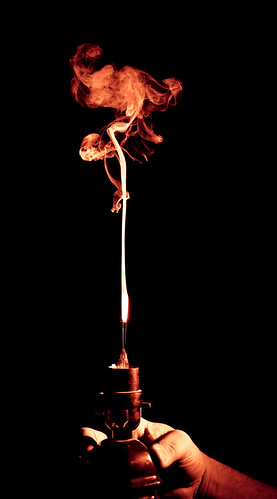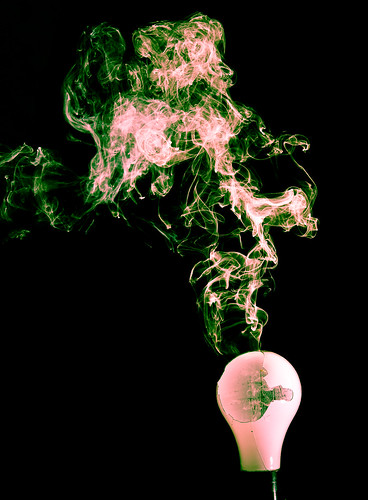 I have always been fascinated by the little things in life: each grain of sand at the beach tanning under a beautiful summer sun, snow flakes falling and swirling on their long descent only to land and melt in my mouth, and watching wisps of smoke curling and winding their way through invisible currents in the air.
I have always been fascinated by the little things in life: each grain of sand at the beach tanning under a beautiful summer sun, snow flakes falling and swirling on their long descent only to land and melt in my mouth, and watching wisps of smoke curling and winding their way through invisible currents in the air.This week's special was smoke. Both from burning incense and light bulb filaments. After seeing a few shots from a few friends we decided it would be fun to try, but we wanted to add something to the mix. Why not add smoke rings?
The first task was to figure out how to make a smoke ring, and based on a demonstration in a Physics class I decided we needed a Vortex Cannon. A simple device that creates a smoke vortex (ring) and sends it flying through the air. A quick search on Google revealed several designs, but they basically all consisted of a tube with a venturi at one end and a diaphragm at the other.
Now we needed to generate some smoke so we bought some light bulbs, incense, and an old lamp from Goodwill. The use for the lamp and light bulbs will be clear in a minute. We setup our black backdrop and wireless flashes to the side, and lit the incense to generate smoke. We filled the Vortex Cannon and fired off some nice smoke rings, but quickly found the design of the cannon to be weak. The rings were sma
 ll, and too hard to achieve well defined rings. When we did capture the rings they were really bland and looked like a white circle. Back to the drawing board for a later date.
ll, and too hard to achieve well defined rings. When we did capture the rings they were really bland and looked like a white circle. Back to the drawing board for a later date.With the failed smoke rings we decided to just photograph the incense smoke. We tried various color gels and flash positions until we had some shots we were happy with. The biggest problem we experienced here was with the flash point back at the lens we had some serious flare from dust particles floating through the air.
Finally, we come to the lamp and light bulbs. A light bulb is a simple device developed well over 100 years ago. It is a tungsten wire in a sealed glass shell that is filled with an inert gas. Tungsten is used because it has a high melting point (high enough to radiate a lot of light), but as a downside it will burn at those temperatures in an oxygen atmosphere. That is where the inert gas comes into play; it prevents the filament from burning itself up.
 So what happens if you break the glass shell and let all the protective inert gas out and light the bulb? Well, the element burns bright for a second or two before dying a horrible fiery and smokey death! (don't try this at home without proper precautions). A great fleeting moment to photograph. So with the same setup as the incense we flashed our way through a dozen light bulbs.
So what happens if you break the glass shell and let all the protective inert gas out and light the bulb? Well, the element burns bright for a second or two before dying a horrible fiery and smokey death! (don't try this at home without proper precautions). A great fleeting moment to photograph. So with the same setup as the incense we flashed our way through a dozen light bulbs.Even though I didn't capture any smoke rings how I wanted, I was happy with the results from the light bulbs and the incense smoke. The smoke rings will have to wait until another time. We found that not using colored gels on the flashes and just doing any c
 olor adjustments in post processing was an easier route, and far more flexible. The smoke takes color well in front of the solid black background.
olor adjustments in post processing was an easier route, and far more flexible. The smoke takes color well in front of the solid black background.Smoke is such a little thing. A fleeting moment that is ever changing, like the sand at the beach or the snow blowing in the wind. Each of these moments draws my complete attention. Day to day thoughts slip into oblivion and my mind is focused. Nothing else matters but the sand beneath my feet, the snow hitting my face, or the smoke in the air. I love photography because of this. I use the camera as my tool to draw me into the Zone and capture these special moments.
Eric

I love the last photo and may have to borrow the idea for a future class shoot!
ReplyDelete